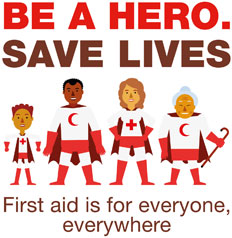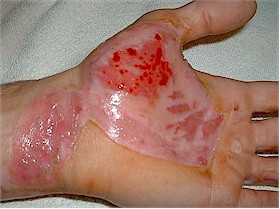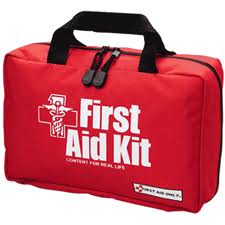
Introduction
Emergency case occurred in unexpected situation. We must have knowledge to extent someone’s life and without prolonging the injury.
First Aid
First aid is the first line of care given to an injured person or sick person given to an ill or injured person before regular medical aid can be obtained.
Basic First Aid
First before doing some first aid is clearing the scene so that the procedure will be implemented properly. There are times that a help is needed in doing it. Remember do not move the patient if it will extent his/her injury.
Following are some basic first aid procedures for treating burns, bleeding and wounds, and . These techniques can be used in some cases,in the workplace ,or at home and being prepared will help make the most of a serious situation.

BURN

1. Cool the affected area of skin by running into a water for 10 minutes.
2. Remove any restrictive jewelries.
3. Apply the clean dressing.
WOUND

1. Stop the bleeding. Use a piece of gauze to stop the bleeding by applying direct pressure to the wound.
2. Elevate. Make sure to elevate the affected area.
3. Make sure to clean the affected area by using soap and water.
4. Apply a clean gauze or piece of clothing into the wound.
SHOCK

1. Reassure the patient.
2. Raise the patient’s legs (unless they have fractures or a snake bite) above the level of the heart, with head flat on the floor.
3. Treat any wound or burn and immobilize fracture.
4. Loosen tight clothing around neck, chest and waist.
5. Maintain the patient’s body warmth with a blanket or similar. Do not use any source of direct heat.
6. Give small, frequent amounts of water to the conscious patient who does not have abdominal trauma and who is unlikely to require an operation in the immediate future.
Monitor and record breathing, pulse and skin color at regular intervals.
Place the patient in the recovery position if the person:
-has difficulty breathing
-becomes unconscious
-is likely to vomit.
FIRST AID KIT

Here’s a breakdown of some supplies every first aid kit needs.
Dressings and bandages:
- 25 adhesive bandages of various sizes (brand names: Band-Aid, Curad, others)
- 5 sterile gauze pads (3 x 3 inches)
- 5 sterile gauze pads (4 x 3 inches)
- Gauze roll
- Eye shield or pad
- Roll of adhesive tape
- Elastic bandage (brand names: ACE, Coban, others) for wrapping wrist, elbow, ankle and knee injuries (3 to 4 inches wide)
- 2 triangular bandages for wrapping injuries and making arm slings
- Sterile cotton balls and cotton-tipped swabs
Equipment and other supplies:
- 2 pair latex or non-latex gloves (These should be worn any time you may be at risk of contact with blood or body fluid of any type.)
- Instant cold pack
- 5 safety pins to easily fasten splints and bandages
- Turkey baster or other suction device to flush out wounds
- Aluminum finger splint
- Syringe and medicine spoon for giving specific doses of medicine
- Thermometer
- Tweezers to remove ticks, insect stingers and small splinters
- Scissors for cutting gauze
- Breathing barrier for giving CPR
- Blanket
- Hand sanitizer (liquid and/or wipes)
- First aid manual
- List of emergency numbers
Medicine for cuts and injuries:
- Antiseptic solution or wipes, such as hydrogen peroxide, povidone-iodine (one brand name: Betadine) or chlorhexidine (one brand name: Betasept)
- Antibiotic ointment (brand names: Neosporin, Bactroban) that contain ingredients such as bacitracin or mupirocin
- Sterile eyewash or saline, such as contact lens saline solution
- Calamine lotion for stings or poison ivy
- Hydrocortisone cream, ointment or lotion for itching
Other medicines:
- Pain and fever medicines, such as aspirin, acetaminophen (one brand name: Tylenol) or ibuprofen (brand names: Advil, Motrin). (Note: Do not give children and teenagers aspirin, because it has been related to a potentially serious disease called Reye’s syndrome in children younger than 18 years of age.)
- Antihistamine (one brand name: Benadryl) to treat allergies and swelling
- Decongestants to treat nasal congestion
- Anti-nausea medicine to treat motion sickness and other types of nausea
- Anti-diarrhea medicine
- Antacid to treat upset stomach
- Laxative to treat constipation
Published: Jul 24, 2016
Latest Revision: Jul 24, 2016
Ourboox Unique Identifier: OB-178288
Copyright © 2016








